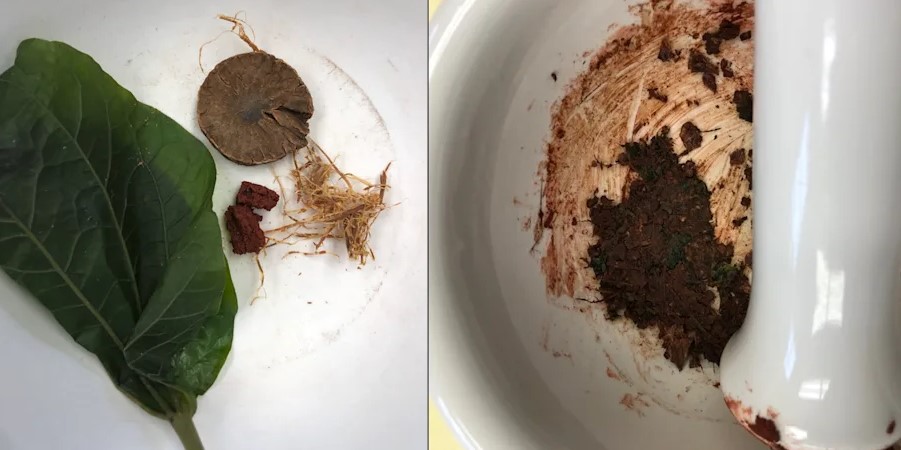Bronze-Age communities in Thailand used psychoactive betel nuts to enhance their alertness, relax their bodies and minds, and generate a sense of euphoria. Though demonized and banned in the country’s urban regions today, the natural stimulant continues to be consumed ritually and recreationally in rural areas, and may have played a role in religious practices 4,000 years ago.
Belonging to the palm family, the betel nut tree grows throughout Southeast Asia and the Pacific islands. Typically, the nut is chewed with leaves and limestone paste, generating copious amounts of red saliva that requires continuous spitting.

The components of a traditional betel nut chewing quid, and the red liquid produced by chewing.
Image credit: Piyawit Moonkham
Archaeological sites across the region have yielded betel nutshells while some skeletons have been found with brown or black stained teeth, which may be indicative of long-term betel nut chewing. Yet new research has shown that even those without darkened teeth might have engaged in the practice.
At the Bronze Age site of Nong Ratchawat in central Thailand, the authors of a new study found the oldest known evidence of betel nut consumption by examining dental plaques taken from the mouths of six skeletons, none of whom displayed any of the typical signs associated with chewing the stimulant.
In the dental calculus of one female individual who lived around 4,000 years ago, the researchers discovered traces of arecoline and arecaidine, which are among the primary psychoactive components in betel nuts. Based on ethnographic interviews with present-day users of the substance, the authors suggest that ancient Southeast Asians may have held a range of traditional beliefs regarding betel nut chewing.

An ancient burial at Nong Ratchawat.
Image credit: Piyawit Moonkham
For instance, they write that “some communities credit ceremonial use with healing metal-related injuries (e.g., nail injuries) and wounds from animal attacks,” while there’s also evidence that the nut was used in agricultural rituals. Speaking to IFLScience, study author Piyawit Moonkham explained that “people used betel nuts as offerings for the spirits, especially during the harvest season, in order to ask the gods for help with rice [cultivation] and the paddy fields.”
I tried it myself, and it stimulates some senses while soothing the whole body.
Piyawit Moonkham
“Understanding the cultural context of traditional plant use is a larger theme we want to amplify – psychoactive, medicinal, and ceremonial plants are often dismissed as drugs, but they represent millennia of cultural knowledge, spiritual practice, and community identity,” Moonkham added in a statement.
As for the psychoactive effects of the nut, Moonkham said, “I tried it myself, and it stimulates some senses while soothing the whole body… I think it’s the same kind of reaction that we have when we drink coffee or smoke tobacco.” However, due to the plant’s negative impact on oral health, consumption in public spaces has been banned since the early 1940s, leading to a loss of traditional practices and beliefs in many of Thailand’s most populated regions.
“Since the Thai government prohibited betel nut chewing, most research has shifted to focusing on its negative effects,” says Moonkham. “But before this, the plant had a lot of social, cultural and religious significance.”
“So the information [in the new study] can tell us about human-plant interactions from the past to the present and help us to change or re-think our relationship with psychoactive plants in particular.”
The study is published in the journal Frontiers in Environmental Archaeology.
Source Link: Humans Were Buzzing On Psychoactive Betel Nuts 4,000 Years Ago